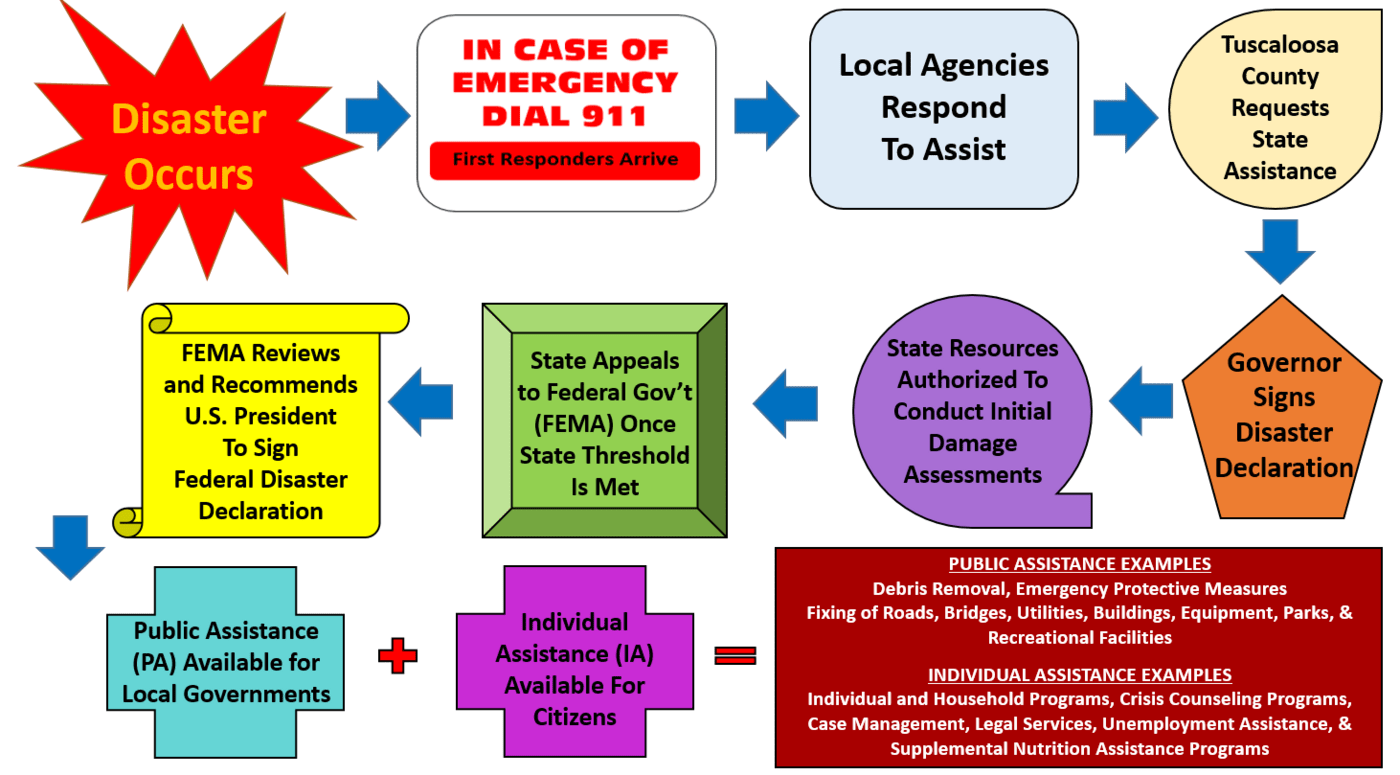
VISUAL OF THE DISASTER ASSISTANCE PROCESS
(A local threshold at the county level has to be met before it is submitted to state and the governor signs a disaster declaration)
For a video and more information on the process outlined above Click Here.
It is important to be prepared and have a plan for a disaster before it strikes. Please visit our PREPARATION AND SAFETY tab to get your family or group ready!
Depending on the scale of a disaster, Tuscaloosa County EMA may or may not activate its Emergency Operations Center (EOC). WHAT IS THE EOC?
Should a disaster occur, Tuscaloosa County EMA Staff and volunteers may come to your home and do a damage assessment. If the damage meets the Tuscaloosa County Threshold of ($930,848) the Assessments are then sent to the Alabama Emergency Management Agency (AEMA). AEMA reviews the information and decides if the State Threshold ($8,189,575) is met. If damage meets the State Threshold, AEMA will do an independent damage assessment before submitting their findings to the Federal Government for review. After the review, FEMA will make a determination on which assistance will be sent to the affected area.
For Federal financial assistance, financial damage and homeowners insurance will determine a reimbursement amount (if any) for a primary residence. There is not a threshold amount under individual assistance.
Assistance can range from providing assistance from all FEMA programs to only providing the ability to receive a Small Business Administration (SBA) loan. These are low-interest loans for individuals or businesses in the affected area.
DISASTER ASSISTANCE
Insurance is the first resource in recovering from a disaster. Contact your insurance agent or company representative to report your losses, review your coverage, and answer any questions. The Alabama Department of Insurance provides assistance with insurance issues and can be reached by calling 334-241-4141 or by visiting the Department of Insurance website by Clicking Here
In the event of a natural or man-made disaster, emergency declarations occur at the state and national levels for designated communities. At the local level, the Tuscaloosa County Emergency Management Agency (TCEMA) works closely with the Alabama Emergency Management Agency (AEMA), the Federal Emergency Management Agency (FEMA), and other partners.

INDIVIDUAL ASSISTANCE VS PUBLIC ASSISTANCE
Individual Assistance (IA)
Individual assistance is provided by the FEMA directly to eligible individuals and families who have sustained losses due to disasters.
- Homeowners or renters in designated counties who sustained damage to their primary homes, vehicles, and personal property as a result of storms may apply for Disaster Assistance.
- Disaster assistance may include grants to help pay for temporary housing, including rental and lodging expenses; emergency home repairs; uninsured and underinsured personal property losses; and medical, dental, and funeral expenses caused by a disaster, along with other serious disaster-related expenses.
- Disaster assistance grants are not taxable income and will not affect eligibility for Social Security, Medicaid, Medical Waiver Programs, Welfare Assistance, Temporary Assistance for Needy Families, Food stamps, Supplemental Security Income or Social Security Disability Insurance.
- Low-interest disaster loans from the Small Business Administration may be available for businesses of all sizes (including landlords), private non-profit organizations, homeowners, and renters. Low-interest disaster loans help pay for repairs or rebuilding efforts and cover the cost of replacing lost or disaster-damaged real estate and personal property. Economic injury disaster loans are available to businesses and private nonprofits to help with working capital needs as a direct result of a disaster.
- For more on Individual Assistance Click Here.
Public Assistance (PA)
Public assistance can reimburse government agencies for emergency protective measures, debris removal, and infrastructure repairs or replacement needed due to disaster-related damage.
- FEMA will provide reimbursement of at least 75 percent of eligible costs, with the state and local governments sharing the remaining 25 percent of costs. Eligible entities include state governments, local governments, and certain private nonprofit organizations, such as schools and public utility districts.
- Although funds are awarded to government entities and certain private nonprofits, the public assistance program is intended to benefit everyone — neighborhoods, cities, counties, and states. Public assistance dollars help clean up communities impacted by disaster-related debris, repair roads and bridges, and put utilities and water systems back in order.
Public Assistance Forms and Resources
FEMA 2019 Equipment Rates (PDF): These equipment rates apply to disasters occurring after 2018.
FEMA Public Assistance Donated Resources Criteria: Eligible activities with Donated Resources and Volunteer Labor.
FEMA Public Assistance Donated Resources Policy: Donated Resources and Volunteer Labor.
FEMA Top 10 Procurement Under Grant Mistakes: Top 10 procurement under grant mistakes that may lead to loss of FEMA public assistance funding
FEMA How to Avoid the Top 10 Procurement Under Grant Mistakes: Key points for non-state entities on how to avoid the top 10 procurement under grant mistakes.
Public Assistance Contracting Requirements Checklist: A checklist for entities on requirements for contracts.
Applicant Responsibilities During a Preliminary Damage Assessment (PDA) for FEMA Public Assistance
Individual Assistance Forms and Resources

